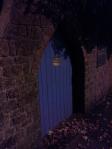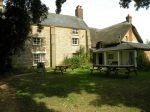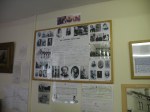Richard Jefferies – Swindon born writer of ‘Post-apocalyptic fiction’ – amongst other things…
The Richard Jefferies museum at Coate is yet another one of those things/places I’ve always been meaning to do but have never got round to. I confess I knew little or nothing about him other than that he was, in his day, a well-known writer from Swindon. Which is a bit poor for a literature student really. Ooops. One of these days I will get round to visiting his museum but in the meantime my good friend Irene Berridge has written me a lovely little guest post about it. So thanks to that, and to a little bit of research quickly done to add to Irene’s post, I now know just a little more about Swindon’s exponent of ‘Post-apocalyptic fiction’. Who’d have thought it?
From the website of the Richard Jefferies Society: “(John) Richard Jefferies (6 November 1848 – 14 August 1887) is best known for his writings about nature and the countryside. His birthplace and home at Coate, now on the out-skirts of Swindon, provide the background to all his major works of fiction and for many of his essays.”
For those of you who are not familiar with the man and his work here’s a further extract from the splendid website dedicated to him, which is the work of the Richard Jefferies society followed by Irene’s splendid post.
‘(John) Richard Jefferies (1848-1887) is best known for his prolific and sensitive writing on natural history, rural life and agriculture in late Victorian England. However, a closer examination of his career reveals a many-sided author who was something of an enigma. To some people he is more familiar as the author of the children’s classic Bevis or the strange futuristic fantasy *‘After London’, while he also has some reputation as a mystic worthy of serious study.’
“Many of you will have heard of Richard Jefferies, who was born at Coate Farm in 1848, and who spent much of his young life using Coate Water as an adventure playground. Have you visited the house of his birth, now a museum? This is tucked away at the back of Sun Inn, and is accessible from the overflow car park at Coate Water, through a narrow gate. The museum is open most Sundays, between 2 – 5, May to September, and every second Wednesday of the month, 2 – 4. It is worth a visit to see the many exhibits. If you are unable to make the visit there are some fairly well planned leaflets, available from the Main Library. One, produced by Mark Daniel, is entitled In the footsteps of Richard Jefferies – Coate Water and as well as very useful information, he has included a map in the centre of the leaflet of a walk, which takes approx. 2 hours, around the Coate Water complex, highlighting areas mentioned in Jefferies book Bevis. This would be a fun walk for children on a half-term break, (may take some a little longer than the 2 hours), but not to be missed. If you fancy a longer walk (perhaps doing it in stages) another leaflet maps out routes which take in Hodson, Wroughton, Avebury, Badbury, Chiseldon, and many other areas, and ending at Marlborough and Savernake Forest. Now is the time for that autumnal walk. Get your walking gear together and start roaming.
There’s lots of information on Richard Jefferies available in the Main Swindon Library. Some books are available to borrow, and for the young reader Bevis is truly full of adventures of the days before computers. On the second floor of the library there is a great amount of information that you can sit and browse through. Find him on the internet as well.”
* From Wikipeadia – on ‘After London’
“Jefferies’ next novel, After London (1885), can be seen as an early example of “post-apocalyptic fiction“: after some sudden and unspecified catastrophe has depopulated England, the countryside reverts to nature, and the few survivors to a quasi-medieval way of life.
The book has two parts. The first, “The Relapse into Barbarism”, is the account by some later historian of the fall of civilisation and its consequences, with a loving description of nature reclaiming England: fields becoming overrun by forest, domesticated animals running wild, roads and towns becoming overgrown, the hated London reverting to lake and poisonous swampland. The second part, “Wild England”, is largely a straightforward adventure set many years later in the wild landscape and society (here too Jefferies was setting an example for the genre); but the opening section, despite some improbabilities, has been much admired for its rigour and compelling narrative.”
Richard Jefferies and his work are also discussed on ‘Victorian Web’.
And here’s a picture of the man himself from Swindon Local.
#swindon #wiltshire #swindonblog #swindon blog #thingstodoinswindon #thingstoseeinswindon #whattodoinswindon #swindonia #swindoniablog #hiddenswindon #swindonian #art #museum #richardjefferies








Trackbacks / Pingbacks